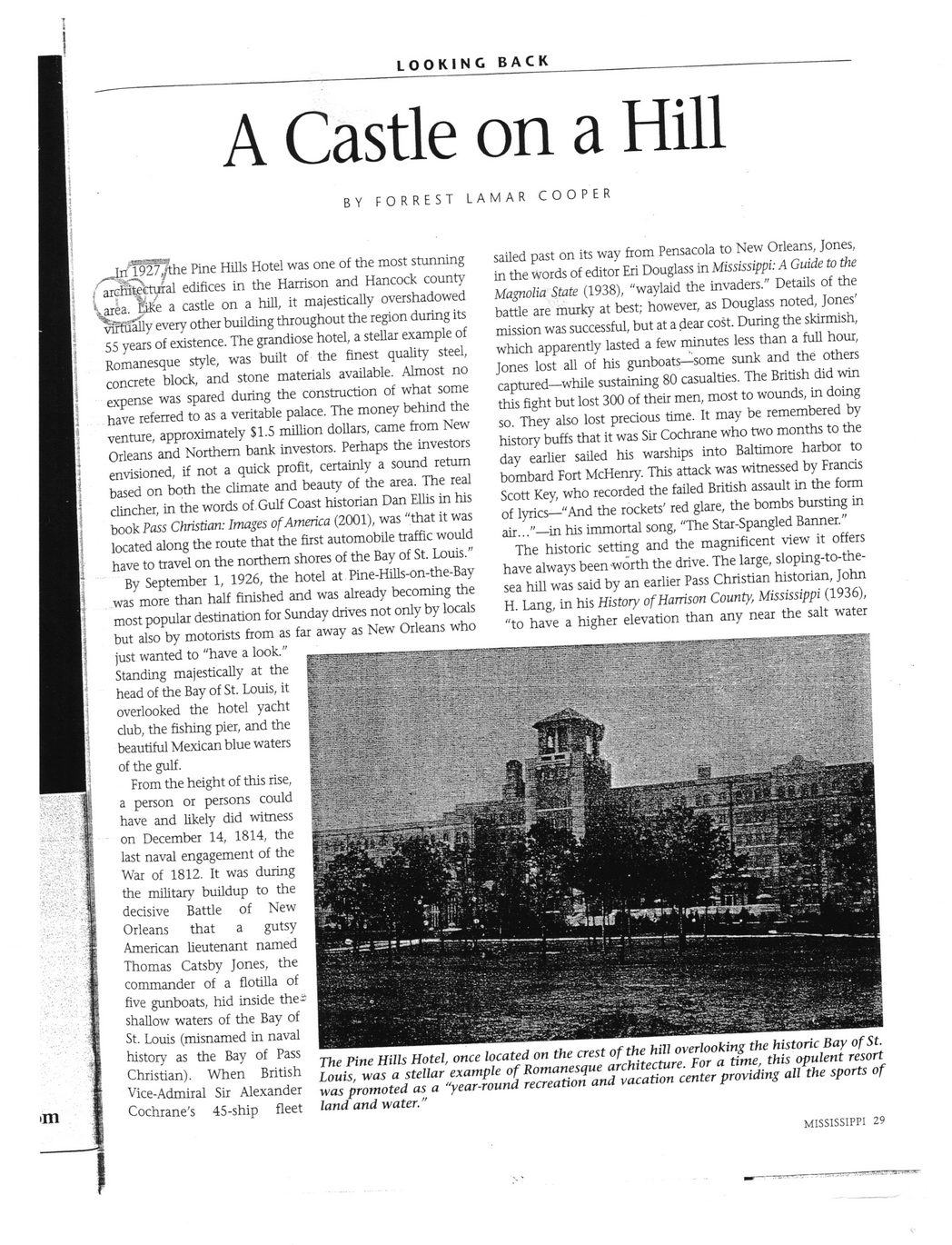This text was obtained via automated optical character recognition.
It has not been edited and may therefore contain several errors.
LOOKING BACK A Castle on a Hill BY FORREST LAMAR COOPER TrTp927.ythe Pine Hills Hotel was one of the most stunning ; architectural edifices in the Harrison and Hancock county Varea. CiKe a castle on a hill, it majestically overshadowed vfffiaUy every other building throughout the region during its 55 years of existence. The grandiose hotel, a stellar example of Romanesque style, was built of the finest quality steel, concrete block, and stone materials available. Almost no expense was spared during the construction of what some have referred to as a veritable palace. The money behind the venture, approximately $1.5 million dollars, came from New Orleans and Northern bank investors. Perhaps the investors envisioned, if not a quick profit, certainly a sound return based on both the climate and beauty of the area. The real clincher, in the words of Gulf Coast historian Dan Ellis in his book Pass Christian: Images of America (2001), was "that it was located along the route that the first automobile traffic would have to travel on the northern shores of the Bay of St. Louis." By September 1, 1926, the hotel at Pine-Hills-on-the-Bay was more than half finished and was already becoming the most popular destination for Sunday drives not only by locals but also by motorists from as far away as New Orleans who just wanted to "have a look." Standing majestically at the head of the Bay of St. Louis, it overlooked the hotel yacht club, the fishing pier, and the beautiful Mexican blue waters of the gulf. From the height of this rise, a person or persons could have and likely did witness on December 14, 1814, the last naval engagement of the War of 1812. It was during the military buildup to the decisive Battle of New Orleans that a gutsy American lieutenant named Thomas Catsby Jones, the commander of a flotilla of five gunboats, hid inside thei shallow waters of the Bay of St. Louis (misnamed in naval history as the Bay of Pass Christian). When British Vice-Admiral Sir Alexander Cochrane's 45-ship fleet sailed past on its way from Pensacola to New Orleans, Jones, in the words of editor Eri Douglass in Mississippi: A Guide to the Magnolia State (1938), "waylaid the invaders." Details of the battle are murky at best; however, as Douglass noted, Jones' mission was successful, but at a dear cost. During the skirmish, which apparently lasted a few minutes less than a full hour, Jones lost all of his gunboats—some sunk and the others captured—while sustaining 80 casualties. The British did win this fight but lost 300 of their men, most to wounds, in doing so. They also lost precious time. It may be remembered by history buffs that it was Sir Cochrane who two months to the day earlier sailed his warships into Baltimore harbor to bombard Fort McHenry. This attack was witnessed by Francis Scott Key, who recorded the failed British assault in the form of lyrics—"And the rockets' red glare, the bombs bursting in air..."—in his immortal song, "The Star-Spangled Banner." The historic setting and the magnificent view it offers have always been-worth the drive. The large, sloping-to-the-sea hill was said by an earlier Pass Christian historian, John H. Lang, in his History of Harrison County, Mississippi (1936), "to have a higher elevation than any near the salt water The Pine Hills Hotel, once located on the crest of the hill overlooking the historic Bay of St. Louis, was a stellar example of Romanesque architecture. For a time, this opulent resort was promoted as a "year-round recreation and vacation center providing all the sports of land and water." MISSISSIPPI 29

Pine Hills Document (044)